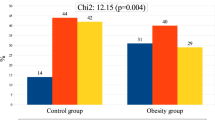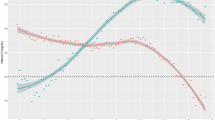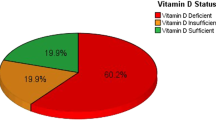Abstract
Objectives: To study the prevalence of hypovitaminosis D, the effect of vitamin D supplementation on serum 25-hydroxyvitamin D [S-25(OH)D], and the intakes of vitamin D and calcium in Finnish 9− to 15-year-old athletic and nonathletic girls.
Design: 1-year follow-up study (February 1997-March 1998) with three months of vitamin D supplementation (10 μg/d) from October to January.
Setting: Turku University Central Hospital, Finland.
Subjects: 191 female volunteers aged 9–15 y (131 athletes and 60 controls).
Methods: Vitamin D and calcium intakes were estimated by a four-day food recording and a semi-quantitative food frequency questionnaire (FFQ). S-25(OH)D was followed by radioimmunoassay (RIA).
Results: At baseline the mean S-25(OH)D concentration was 33.9 nmol/l among all girls. In winter severe hypovitaminosis D (S-25(OH)D<20 nmol/l) occurred in 13.4% of the participants and in 67.7% S-25(OH)D was below 37.5 nmol/l. By the next summer the mean S-25(OH)D concentration was 62.9 nmol/l and in 1.6% of the subjects it was below 37.5 nmol/l. The prevalence of severe hypovitaminosis D was not significantly reduced by three months of vitamin D (10 μg/d) supplementation. At baseline, the mean intake of vitamin D was 2.9 μg/d by food recording and 4.3 μg/d by FFQ. The mean calcium intake was 1256 mg/d and 1580 mg/d, respectively. The intakes of vitamin D and calcium remained unchanged during the follow-up period. The athletes consumed more calcium than nonathletic controls, whereas the intake of vitamin D was quite similar among both groups. The vitamin D intake by FFQ correlated with the S-25(OH)D concentration in wintertime (r=0.28, P<0.01).
Conclusion: Hypovitaminosis D is fairly common in growing Finnish girls in the wintertime, and three months of vitamin D supplementation with 10 μg/d was insufficient in preventing hypovitaminosis D. The daily dietary vitamin D intake was insufficient (<5 μg/d) in the majority of participants, while the calcium intake was usually sufficient.
Sponsorship: Supported by the Yrjö Jahnsson Foundation, The Turku University Foundation, and the Medical Research Foundation of the Turku University Central Hospital.
This is a preview of subscription content, access via your institution
Access options
Subscribe to this journal
Receive 12 print issues and online access
$259.00 per year
only $21.58 per issue
Buy this article
- Purchase on Springer Link
- Instant access to full article PDF
Prices may be subject to local taxes which are calculated during checkout
Similar content being viewed by others
Author information
Authors and Affiliations
Contributions
Contributors: All investigators contributed to the study design and writing of the paper. Marjo Lehtonen-Veromaa recruited patients, conducted the interviews and contributed to data analysis, and wrote the first draft of the manuscript. Timo Möttönen was the leader of the study, advised and took an active role in the study design, conducted data analysis, revised the manuscript, and acts as guarantor. Kerttu Irjala supervised the lab work and revised the manuscript. Merja Kärkkäinen and Christel Lamberg-Allardt developed FFQs and revised the manuscript. Pasi Hakola performed statistical analysis. Jorma Viikari contributed to the data management and revision of the manuscript, and supervised the study.
Rights and permissions
About this article
Cite this article
Lehtonen-Veromaa, M., Möttönen, T., Irjala, K. et al. Vitamin D intake is low and hypovitaminosis D common in healthy 9− to 15-year-old Finnish girls. Eur J Clin Nutr 53, 746–751 (1999). https://doi.org/10.1038/sj.ejcn.1600844
Received:
Revised:
Accepted:
Published:
Issue Date:
DOI: https://doi.org/10.1038/sj.ejcn.1600844
Keywords
This article is cited by
-
Does vitamin D affect strength and speed characteristics and testosterone concentration in elite young track and field athletes in the North European summer?
Nutrition Journal (2023)
-
Concentration levels of serum 25-Hydroxyvitamin-D and vitamin D deficiency among children and adolescents of India: a descriptive cross-sectional study
BMC Pediatrics (2021)
-
Epidemiology and risk factors of hypovitaminosis D in a cohort of internationally adopted children: a retrospective study
Italian Journal of Pediatrics (2018)
-
Bone mineral density, vitamin D status, and calcium intake in healthy female university students from different socioeconomic groups in Turkey
Archives of Osteoporosis (2018)
-
Vitamin D deficiency in Swiss elite wheelchair athletes
Spinal Cord (2016)



